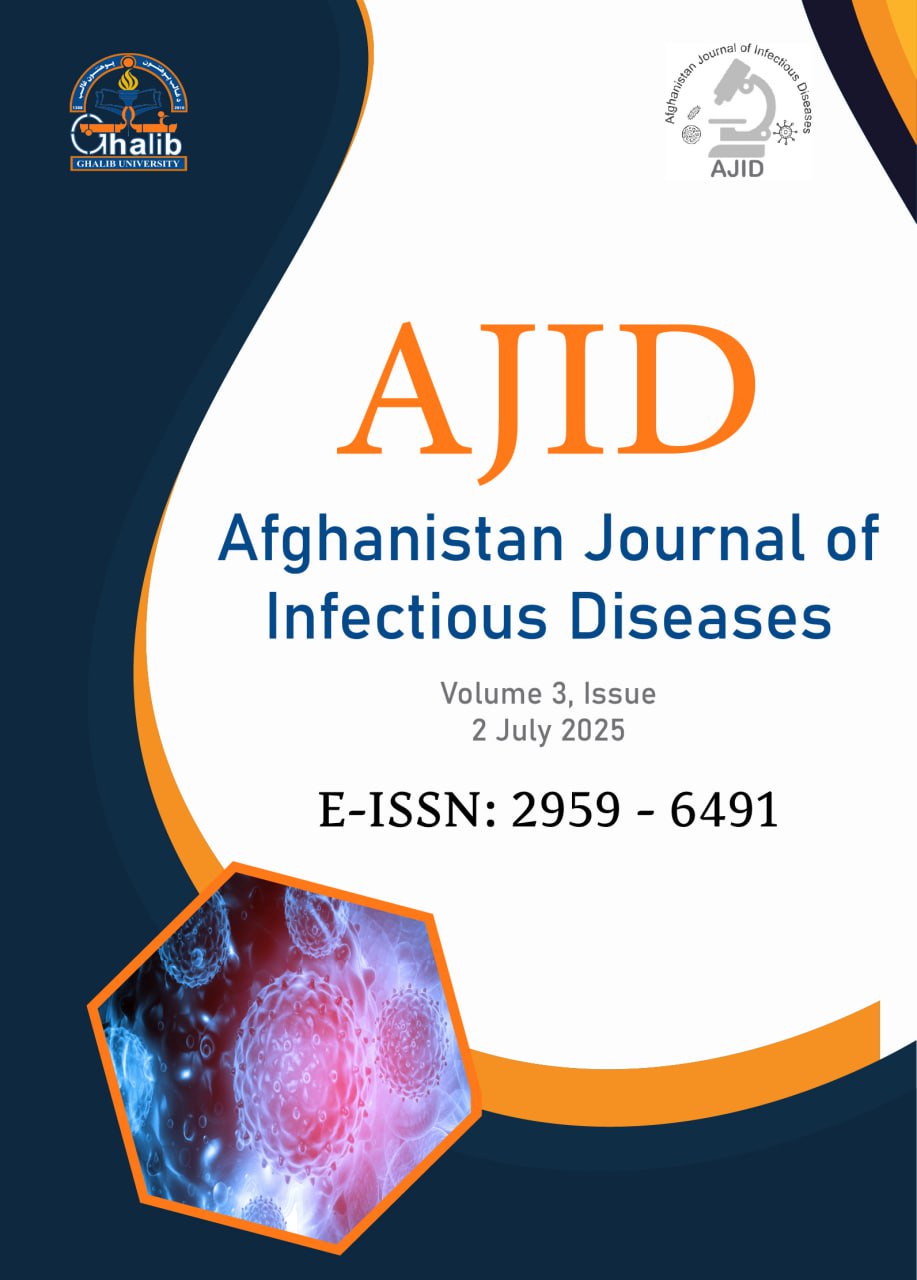Knowledge and Practices Regarding Pet Ownership and Parasitic Zoonoses among Medical Students and Faculty in Kabul, Afghanistan: A Focus on Toxocariasis
Main Article Content
Abstract
Background: Toxocariasis is a common but often neglected parasitic zoonosis, transmitted mainly through contact with contaminated animals or soil. Despite its public health significance, awareness remains limited, particularly in Afghanistan. We aimed to assess the awareness and practices related to pet ownership and the risk of Toxocara infection among medical students and faculty members at two major private medical universities in Kabul.
Methods: This cross-sectional study surveyed 347 medical students and faculty members at Ghalib University and Cheragh Medical Educational Institute in Kabul between Oct and Dec 2023. A semi-structured questionnaire assessed sociodemographic factors, behaviors related to animal contact, and knowledge of zoonotic parasites, with a focus on Toxocara. Associations between pet ownership and knowledge or practices were examined using chi-square tests.
Results: Overall, 38.8% of participants reported owning pets. While 41.5% indicated high knowledge of zoonotic parasites, only 8.1% could name Toxocara specifically. Veterinary visits were common among pet owners. Pet ownership was significantly associated with sex, frequency of contact with stray animals, daily interactions with animals, knowledge of parasitic zoonoses, and awareness of the clinical spectrum (P<0.05). Hygiene practices after animal contact did not differ significantly between groups, although handwashing with water alone was most commonly reported. Knowledge regarding transmission routes, the ability to name parasites in general, zoonotic parasites, and Toxocara was similarly limited among both pet owners and non-owners.
Conclusion: Substantial gaps in knowledge about parasitic zoonoses, including Toxocara, were identified. Pet ownership influenced certain behaviors but did not consistently predict higher awareness. These findings underscore the need for targeted educational interventions to strengthen understanding and promote preventive measures among future healthcare professionals.
Article Details

This work is licensed under a Creative Commons Attribution 4.0 International License.
References
Macpherson CN. The epidemiology and public health importance of toxocariasis: A zoonosis of global importance. Int J Parasitol. 2013;43:999-1008.
Rostami A, Riahi SM, Holland CV, Taghipour A, Khalili-Fomeshi M, Fakhri Y, et al. Seroprevalence estimates for toxocariasis in people worldwide: A systematic review and meta-analysis. PLoS Negl Trop Dis. 2019;13:e0007809.
Rostami A, Riahi SM, Hofmann A, Ma G, Wang T, Behniafar H, et al. Global prevalence of Toxocara infection in dogs. Adv Parasitol. 2020;109:561-583.
Rostami A, Sepidarkish M, Ma G, Wang T, Ebrahimi M, Fakhri Y, et al. Global prevalence of Toxocara infection in cats. Adv Parasitol. 2020;109:615-639.
Merigueti YFFB, Giuffrida R, Silva RCd, Kmetiuk LB, Santos APD, Biondo AW, Santarém VA. Dog and cat contact as risk factor for human toxocariasis: Systematic review and meta-analysis. Front Public Health. 2022;10:854468.
Keegan JD, Airs PM, Brown C, Dingley AR, Courtney C, Morgan ER, Holland CV. Park entrances, commonly contaminated with infective Toxocara canis eggs, present a risk of zoonotic infection and an opportunity for focused intervention. PLoS Negl Trop Dis. 2025;19:e0012917.
Nikopoulou A, Sideras L, Peristeri AM, Ligda P, Akritidou O, Sotiraki S. Human toxocariasis: Presenting a case report of eosinophilic myocarditis associated with Toxocara canis infection and a literature review. Microbiol Res. 2025;16:58.
Strube C, Heuer L, Janecek E. Toxocara spp. Infections in paratenic hosts. Vet Parasitol. 2013;193:375-389.
Despommier D. Toxocariasis: Clinical aspects, epidemiology, medical ecology, and molecular aspects. Clin Microbiol Rev. 2003;16:265-272.
Auer H, Walochnik J. Toxocariasis and the clinical spectrum. Adv Parasitol. 2020;109:111-130.
Eslahi AV, Badri M, Khorshidi A, Majidiani H, Hooshmand E, Hosseini H, Taghipour A, Foroutan M, Pestehchian N, Firoozeh F. Prevalence of Toxocara and toxascaris infection among human and animals in iran with meta-analysis approach. BMC Infect Dis. 2020;20:1-17.
Omer FM, Awadalla NJ, Alsaleem SA, Alsaleem MA, Moosa RA, Alqahtani MA, Asiri AA, Alahmari EM, Alqahtani AN, Mahfouz AA. Toxocara awareness among medical practitioners in Saudi Arabia. EcoHealth. 2021;18:107-112.
Overgaauw PA, van Zutphen L, Hoek D, Yaya FO, Roelfsema J, Pinelli E, van Knapen F, Kortbeek LM. Zoonotic parasites in fecal samples and fur from dogs and cats in the Netherlands. Vet Parasitol. 2009;163:115-122.
Statista. Dogs vs. Cats [chart]. Statista. 2022 [cited 2025 July 2]. Available from: https://www.statista.com/chart/28906/dog-vs-cat-ownership-in-selected-countries/
do Vale B, Lopes AP, Fontes MdC, Silvestre M, Cardoso L, Coelho AC. A cross-sectional study of knowledge on ownership, zoonoses and practices among pet owners in northern Portugal. Animals. 2021;11:3543.
Taha NM, Sabry MA, El-Bahy MM, Ramadan RM. Awareness of parasitic zoonotic diseases among pet owners in cairo, egypt. Vet Parasitol. 2024;51:101025.
Woodhall DM, Garcia AP, Shapiro CA, Wray SL, Shane AL, Mani CS, et al. Assessment of us pediatrician knowledge of toxocariasis. Am J Trop Med Hyg. 2017;97:1243.
Ho J, Hussain S, Sparagano O. Did the covid-19 pandemic spark a public interest in pet adoption? Front Vet Sci. 2021;8:647308.
Holland CV. Knowledge gaps in the epidemiology of toxocara: The enigma remains. Parasitology. 2017;144:81-94.
Saunders J, Parast L, Babey SH, Miles JV. Exploring the differences between pet and non-pet owners: Implications for human-animal interaction research and policy. PLoS One. 2017;12:e0179494.
Defelipe R, Savalli C, Otta E. Demographics and self-reported well-being of Brazilian adults as a function of pet ownership: A pilot study. Heliyon. 2020;6
Westgarth C, Pinchbeck GL, Bradshaw JW, Dawson S, Gaskell RM, Christley RM. Factors associated with dog ownership and contact with dogs in a uk community. BMC Vet Res. 2007;3:1-9.
Nettelrodt KM, von Lengerke T. Self-reported frequency of handwashing among pet and non-pet owners in different situations: Results of four surveys of the general adult population in Germany. BMC Public Health. 2024;24:3581.

